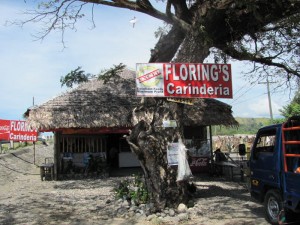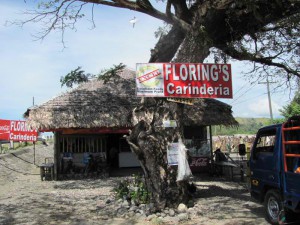By ALEX C. DE LOS SANTOS
 IF you happen to be in Antique make sure to stop by Floring’s. It serves delicious chicken adobo in an ambience uniquely Antique.
IF you happen to be in Antique make sure to stop by Floring’s. It serves delicious chicken adobo in an ambience uniquely Antique.
Floring’s Carinderia is Antique’s version of “the house that chicken built,” the slogan of the long-established Max’s restaurant. It’s right beside the approach to Cangaranan Bridge in Barangay Ilaures, Bugasong and sits cozily under the verdant canopy of an acacia tree.
Floring’s is the refuge of many hungry travellers traversing the national highway through Antique, one of the provinces that comprise the island of Panay, the others being Iloilo, Aklan and Capiz.
Customers come by the busloads or delivery trucks. Salesmen and their crew drop by for breakfast or lunch. Dusty workmen in motorcycles stop by for a plateful. Even Antique’s well-heeled set would park under the shady acacia and grab a meal at Floring’s. On Sundays, they deem it necessary to call for reservations.
According to the eatery’s staff, even the governor or congressman would stop by every now and then to eat at Floring’s.
Yet Floring’s offers nothing but native chicken adobo; it was only recently that they added native chicken tinola (chicken broth with green papaya and pepper leaves) in the menu. Its chicken adobo is deliciously cooked red-orange in its own fat and achuete sauce, garnished with tapering siling labuyo or chilli peppers. The serving is nothing fancy: the chicken cutlets are unceremoniously heaped on a plastic plate, but they disappear no sooner than they are served.
Floring’s chicken adobo has become iconic of Karay-a cuisine. It has also made the pages of glossy magazines, thanks to travelling journalists and writers who had tasted it.
 Its recipe for chicken adobo is not really a secret — one client commented she could cook it at home, but she prefers coming back every now and then.
Its recipe for chicken adobo is not really a secret — one client commented she could cook it at home, but she prefers coming back every now and then.
Floring’s was founded by Florinia Jalipa in 1970. It started out as one of those makeshift eateries at Ilaures junction, where the national highway branches out to mountainous Valderrama town.
At that time, trucks and travellers were few, so they operated on cook-as-you-order basis. Its costumers had to wait until the adobo is cooked. Sometimes, if it runs out of dressed chicken, the wait starts with boiling water with which to scald the chicken still breathing its last.
That also made travelling to the northern part of Antique a lengthy affair, if not a gruesome event compounded by bad roads and lack of sturdy bridges. In those days, travellers had to make a stopover at Ilaures for lunch or to relieve themselves. What is now a two-hour travel used to take a whole day.
When the new Cangaranan Bridge was finished and inaugurated by Gloria Macapagal in 2005, the bridge — which now claims to be the longest in all of Western Visayas — went past the junction, displacing all the vendors in the area. Only Floring’s set up on a narrow piece of lot a few meters from the northern end of the bridge.
The eatery used to have a unique selling strategy: it would serve as many pieces of chicken at the table, and charge the costumers only for what they ate. They would usually consume every piece served anyway, and even ask for extras. This strategy, and its folksy ambience, contributed to Floring’s homey, rustic style that endeared the joint to its clients.
From her Floring’s earnings, Jalipa was able to send her daughters, nieces, and grandchildren to school. Two of her daughters, Charlotte and Judith, help her in the restaurant alternating as cashier and cook.
Floring has moved to the southern end of the bridge where an acacia tree stands. It has grown in size, with three rows of tables that could sit 50 persons at a time. The wide windows delicately braced with bamboo latticework not only offer a view of the rice paddies and the dry riverbed of
Cangaranan, but also let in plenty of fresh air that smells of young rice and dust. The pink floral curtains, soda advertisements, and remnants of last Christmas’s decorations complete the scenario of a provincial lifestyle.
For the hungry traveller, nothing beats eating home cooked chicken adobo al fresco under the acacia tree. It fills not only the stomach but does magic to the spirit.
